

Theory U: Leading from the Future as It Emerges - An Awareness Based. Leaders today are torn between worlds: on the one hand they are confronted with a new set of emerging leadership challenges in a 21st-century world of complexity, chaos, and disruptive change; and on the other they find themselves equipped with a 20th-century management toolkit that is inadequate to fix the problems they face.
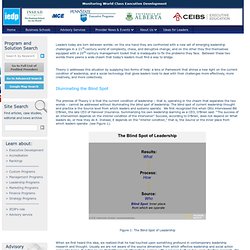
Between these two worlds there yawns a wide chasm that today’s leaders must find a way to bridge. Theory U addresses this situation by supplying two forms of help: a lens or framework that shines a new light on the current condition of leadership, and a social technology that gives leaders tools to deal with their challenges more effectively, more creatively, and more collectively. Illuminating the Blind Spot The premise of Theory U is that the current condition of leadership – that is, operating in the chasm that separates the two worlds – cannot be addressed without illuminating the blind spot of leadership.
Theorie U Infographique. U-Browser. Check out this excellent visualization of Theory U in practice « Tao Bindslev. Otto Scharmer. Microsoft Word - Reams - Reams, Illuminating the Blind Spot 5, 2007.pdf. 2003_TheBlindSpot.pdf. U-procedure and Theory U. U-procedure and Theory U is a change management method to change unproductive patterns of behavior.
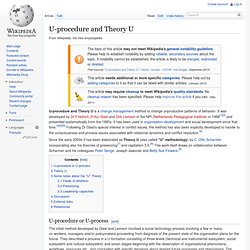
It was developed by Dr Friedrich (Fritz) Glasl and Dirk Lemson of the NPI (Netherlands Pedagogical Institute) in 1968[1][2] and presented systematically from the 1980s. It has been used in organisation development and social development since that time.[3][4][5] Following Dr Glasl's special interest in conflict issues, the method has also been explicitly developed to handle to the consciousness and process issues associated with relational dynamics and conflict resolution.[6] Since the early 2000s it has been elaborated as Theory U (also called "U" methodology) by C.
Otto Scharmer, incorporating also his theories of presencing[7] and capitalism 3.0.[8] This work itself draws on collaboration between Scharmer and his colleagues Peter Senge, Joseph Jaworski and Betty Sue Flowers.[9] U-procedure or U-process[edit] The seven stages consist of: 1. 2. 3. 4. 5. 6. 7. Theory U -> Leading from the Emerging Future.
Dr.
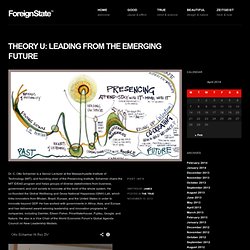
C. Otto Scharmer is a Senior Lecturer at the Massachusetts Institute of Technology (MIT), and founding chair of the Presencing Institute. Scharmer chairs the MIT IDEAS program and helps groups of diverse stakeholders from business, government, and civil society to innovate at the level of the whole system. He co-founded the Global Wellbeing and Gross National Happiness (GNH) Lab, which links innovators from Bhutan, Brazil, Europe, and the United States in order to innovate beyond GDP.
Presencing Institute. The Essence of Theory U and Presencing. Theorie U diaporama V5. Processus-en-U.jpg (Image JPEG, 1920x1527 pixels) - Redimensionnée (53%) Une journée avec Otto Scharmer. A l’occasion de la sortie en France du livre d’Otto Scharmer, La Théorie U, Diriger à partir du futur émergent, Génération Présence et SOL France avaient organisé la semaine dernière une journée avec Otto Scharmer à Paris.
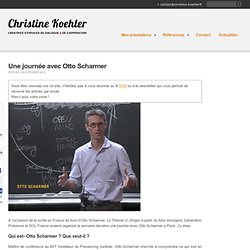
J’y étais. Qui est- Otto Scharmer ? Que veut-il ? Maître de conférence au MIT, fondateur du Presencing Institute, Otto Scharmer cherche à comprendre ce qui met en mouvement les systèmes complexes et les conduit à réussir ou pas leurs processus de changement. Il a introduit le concept de “presencing”, qui, mélange de présence et de ressenti, est un état d’attention particulier permettant aux personnes et aux groupes d’agir sur leur qualité de présence et de s’ouvrir au futur émergent.
Le déroulement de la journée Les concepts A partir de là, Otto Scharmer nous a posé quelques questions fondamentales : • Comment les parties (par exemple les bribes de connaissances individuelles) se connectent-elles au tout ? Jaywalk » Structural Manifestation of Theory U. Otto Scharmer’s book Theory U: Learning from the Future as It Emerges describes “the social technology of presencing”, the theory and practice of the U process that calls for “presence” and “sensing”.

Scharmer maintains that through this “presencing” — being in touch with the inner place from which attention and intention originate — individuals, teams, organizations and global systems alike are able to raise to a higher level of operation, at which they are able to seize the highest future possibilities that “want to emerge”. Theory U is about profound transformation: personal, social and global. The U process leads through seven field structures of attention in an U-shape: downloading, seeing, sensing, presencing, crystallizing, prototyping and performing.
Scharmer describes to great extent how to bring about such a change individually, in organizations and in society, but does not give a proper account of what the change means in structural terms. Figure 1. WhenRealityHits.pdf. From ego-system to eco-system economies. Credit: Shutterstock.

All rights reserved. We live in an age of profound disruptions. Global crises in finance, food, fuel, water, resource scarcity and poverty challenge every aspect of our societies. These disruptions also open up the possibilities for personal and societal renewal. To seize these possibilities we need to stop and ask ourselves some basic questions: why do our actions collectively create results that so few people want? Here’s a clue to the answers to these questions: the root causes of today’s global crises originate between our ears, in our outdated paradigms of economic thought.
The symptoms of these crises can be summarized in three divides that disconnect us from each primary source of life: ecological, social, and spiritual. These structural disconnects indicate a broken system. Otto Scharmer's Blog. 10 insights on the Ego-2-Eco Economy Revolution We live in an age of profound disruption.
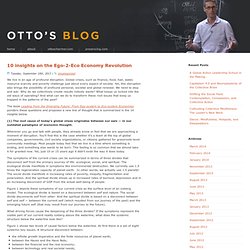
Global crises, such as finance, food, fuel, water, resource scarcity and poverty challenge just about every aspect of society. Yet, this disruption also brings the possibility of profound personal, societal and global renewal. We need to stop and ask: Why do we collectively create results nobody wants? What keeps us locked into the old ways of operating? The book Leading from the Emerging Future: From Ego-system to Eco-system Economies ponders these questions and proposes a new line of thought that is summarized in the 10 insights below.